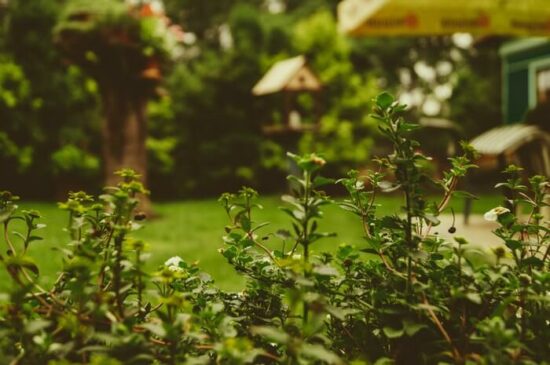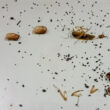Finding effective eco-friendly pest control methods is easier than it sounds. There’s a misconception that environmentally safe options don’t work, and that couldn’t be further from the truth.
This list goes over the best eco-friendly pest control methods and products you can use to get the results you want.
Table of contents
- 1. Introduce Friendly Plants
- 2. Call For Reinforcements
- 3. Take Advantage Of Old Food
- 4. Get Some Insecticidal Oils
- 5. Use Diatomaceous Earth
- 6. Remove Unhealthy Vegetation
- 7. Don’t Forget Your Windows
- 8. Clean with Natural Products
- 9. Keep Unwanted Animals Away
- 10. Harness The Power Of Mulch
- 11. Try Neem Oil
1. Introduce Friendly Plants
One of the best forms of eco-friendly pest control is to utilize Mother Nature’s own tools! Many plants act as natural deterrents against pests and parasites.
In fact, many of the eco-friendly commercial products you see on the market use these plants’ extracts as a base!
Planting a few of these varieties in your garden can do wonders to keep unwanted insects away.
This technique is known as “companion planting.” The friendly plants aren’t your main crop, but they support your other cultivation endeavors. The plants stay near your primary plants, creating an invisible shield of protection!
Some plants will also do double-duty by attracting beneficial insects, such as pollinators. Either way, you have many options!
The go-to for most gardeners are herbs. Fragrant plants release an intense aroma that drives pests away. You can plant the herbs between your primary plants or use them alone inside your home. Many fragrant flowers and bushes serve the same purpose.
Good companion plant options include:
- Lavender
- Basil
- Eucalyptus
- Rosemary
- Petunias
- Chrysanthemums
- Lemongrass
- Clover
- Marigold
2. Call For Reinforcements
Sometimes, you need to attract some backup if you want to practice effective and safe environmentally friendly pest control. And no, we’re not talking about exterminators here!
Some friendly birds and mammals can get rid of unwanted pests for you. Backyard animals can be these pests’ natural predators.
Birds love to snack on slugs, snails, and pretty much any insect they can get their beaks on. Meanwhile, small mammals like to eat bugs in-between nuts and berries!
Attracting these animals can make a noticeable difference in the pest population, all while being as eco-friendly as it gets. Their work reduces the damage to your plants and decreases the chances of disease. On top of all that, they do a lot to create a natural ambiance in your backyard.
So, how do you attract pest-eating animals? You have to build an environment they’ll want to visit. Try installing some nesting boxes, feeders, and birdbaths.
3. Take Advantage Of Old Food
When most people think of old food, the first thought they have is how much of a pest magnet it is! While that may be true for many junk foods, some leftovers can work to your advantage.
If used strategically, some food scraps can work as natural deterrents.
Coffee grounds are one of the most under-utilized forms of food waste that you can recycle. Brewed grounds have a strong scent that insects hate (some even have success using coffee grounds to repel deer)! While it’s not bothersome to us, the aroma is enough to send bugs away (making it an extremely eco-friendly method of pest control).
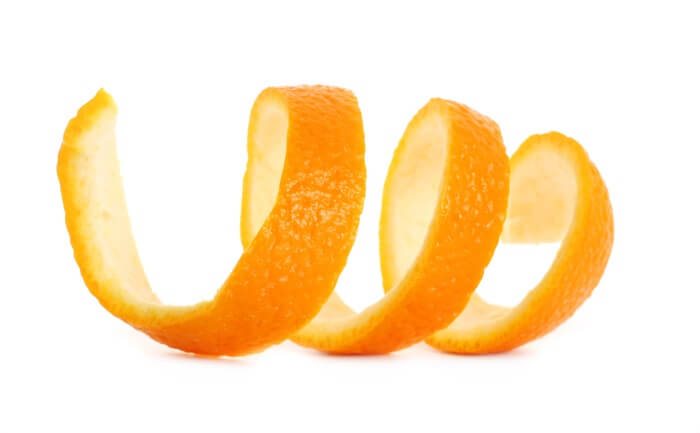
Try spreading those old coffee grounds around problem areas. Spread a thin layer around the perimeter of your home, next to entryways, and more. The grounds will keep ants, mosquitos, bees, and other pests away.
If you have some old citrus peels, you can use them in the garden. Chop the peels up and mix them in with the soil. The essential oils will keep bugs away while the peels fertilize your plants as they decay.
Quick Tip: You can also place the peels near entry points or even on countertops.
Cucumbers and onions can be put to good use as well. Bitter slicing cucumbers are great for repelling ants. Meanwhile, soaking old onion peels in some water will keep mosquito infestations at bay.
4. Get Some Insecticidal Oils
Insecticidal oils are pretty standard in the organic gardening scene. Contrary to popular belief, these products are not chemical-based.
Most are made out of mineral oil, which is refined from naturally occurring crude petroleum. You may also see insecticidal oils that utilize vegetable bases, such as cottonseed or soybean oil.
Either way, insecticidal oils are quite effective at killing eggs and young insects. The product works by disrupting gas exchange. It essentially cuts off the bug’s oxygen supply and suffocates them.
Be extra careful when using insecticidal oils. While not inherently harmful, the formula could negatively impact the health of your plants. Not only that, but these oils are non-selective. That means that it will kill both unwanted bugs and beneficial ones!
5. Use Diatomaceous Earth
Diatomaceous earth is an age-old eco-friendly pest control product that many continue to use.
You can find diatomaceous earth at most hardware stores and gardening centers. It’s a white powder that’s made out of microscopic silica algae shells. Some formulas also contain non-harmful additives like clay or natural minerals.
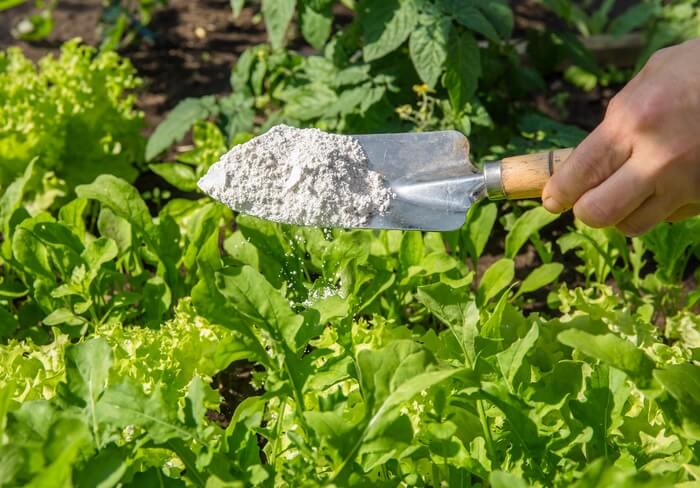
Whatever the case may be, all diatomaceous earth products work the same. The fine powder sticks onto pests. The sharp, microscopic projections physically harm the insect.
In time, it slowly dries the bug out until they dehydrate and die.
Diatomaceous earth is a fantastic solution for a wide range of pests. It’s most effective on soft-bodied bugs like snails, larvae, fleas, roaches, and ants. The powder cuts into the cuticle more effectively on soft-bodied pests. However, it can also harm more formidable insects.
As a whole, diatomaceous earth is a fantastic environmentally friendly option. Not only is it all-natural, but it eradicates pests by physical means. It’s non-toxic and doesn’t cause any harm to plants. You can even apply it directly to foliage without any problems.
That said, the powder may also harm beneficial insects. As a result, it’s essential to exercise caution when applying it to large areas.
6. Remove Unhealthy Vegetation
Did you know that damaged or diseased plants attract more pests than healthy ones?
Discolored and wilting leaves tend to be easier to get through. Plus, they might already have a thriving population of pests to spread the joy!
Regular inspections are a crucial part of pest-free gardening. Examine your plants regularly and keep an eye out for unhealthy foliage. If you encounter any, remove it as soon as possible to mitigate pest problems!
Quick Tip: Pay the same amount of attention to weeds and overgrowth as well. Not only do weeds choke your plants and deprive them of nutrients, but they also create a haven for pests.
7. Don’t Forget Your Windows
Doorways and garages are a pretty common entry point for pests. But have you thought about how many are getting in through your windows? You’d be surprised by how often insects make their way through small cracks and openings.
There are a few ways to keep bugs out. You can use old lemon peels as we mentioned earlier. Or, you can turn to your spice drawer for some other eco-friendly options!
Like fresh herbs in the garden, most bugs detest aromatic spices! You can use that fact to your advantage and create a physical barrier that pests won’t want to cross.
Try sprinkling cinnamon, paprika, black pepper, turmeric, or cayenne. Spread the spice along the windowsill, and make sure there are no gaps for those pesky bugs to push through.
8. Clean with Natural Products
Keeping your home clean is one of the best things you can do to combat pests. While commercial cleaners are convenient and readily available, they can be just as chemical-laden as dangerous insecticides.
Fortunately, creating your own all-natural and eco-friendly pest control product is a breeze.
One of the most uncomplicated formulas is to mix half a cup of white vinegar with two cups of water. Then, add up to 15 drops of your favorite essential oil. Fragrant oils like lavender or eucalyptus work best.
Mix it all together, and you have a powerful cleaner that will cut through anything! The acidic nature of vinegar makes it perfect for getting through grease. Diluting it prevents the overbearing smell from taking over. Plus, it eliminates any remnants of food that could attract pests.
Meanwhile, the essential oils add a pleasant aroma while also deterring pests!
Another option is to add some citrus peels to a jar of vinegar. Let the solution sit for several weeks before diluting it with water.
Similar recipes are available for those instances when you know what kind of pest you’re trying to eliminate. For example, garlic-based cleaners are great for spiders, while peppermint is perfect for ants.
Quick Tip: Don’t be afraid to use your homemade cleaner everywhere! It’s perfect for wiping down counters, cleaning window sills, and even mopping floors. Try it wherever you encounter pests most.
9. Keep Unwanted Animals Away
Earlier, we talked about the perks of having birds and small mammals nearby to eat pests in the area. While birds are pretty harmless, some unwanted animals will do more harm than good.
Rodents like rats and squirrels are particularly annoying if you have fruit-bearing plants. They can destroy your crops while also bringing diseases into the mix. In many cases, these animals can also bring along pests like ticks and fleas!
To avoid those pest problems, you’ll need to keep the unwanted animals out.
Go for a safe, humane, and environmentally friendly method here. Automated sprinklers, predatory urine, and powered fencing are all great options. You can also get a cat or other farm pet!
If all else fails, you can always call an animal control specialist to trap and relocate problematic creatures (or do it yourself).
10. Harness The Power Of Mulch
Mulch is a fantastic landscaping tool that gardeners and farmers have been using since the dawn of time! Mulch is nothing more than chipped wood. Finely cut organic matter, such as leaves and straw, is available too.
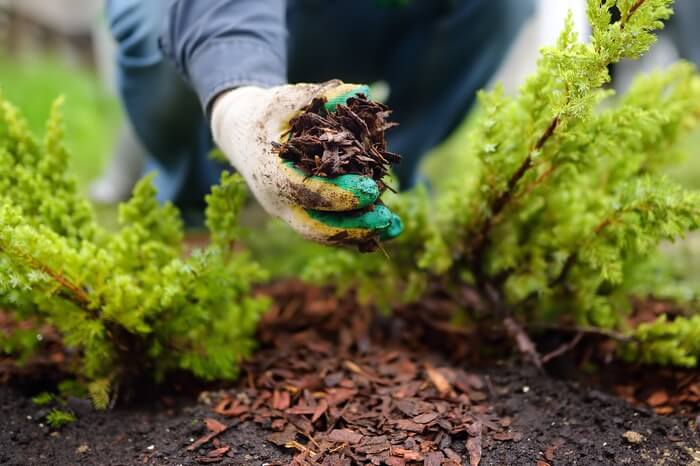
Mulching serves many different purposes. From a landscaping standpoint, it helps create a clean and uniform look. Spread some around the base of your garden bed, and you have an area that looks sleek and maintained.
The product also creates a better growing environment for plants. It prevents soil erosion from rain, retains moisture in times of drought, and deprives weeds of access to sunlight. On top of all that, mulch is an organic product that decays over time. When this happens, it naturally fertilizes the soil underneath!
All of these benefits directly impact the pest population. The mulch eliminates many sources of food and shelter for bugs. They have nothing to gain from mulch, so most bugs will look elsewhere to set up camp!
Mulching can do a lot to improve your garden, and it’s a fantastic eco-friendly pest control tactic as well. It’s well worth the investment!
11. Try Neem Oil
Neem oil is a special type of insecticidal oil that’s readily available in most gardening centers. Technically speaking, it’s a type of vegetable oil. It comes from pressed fruits and seeds of the Neem tree, which is an abundant evergreen tree from India.
The unique thing about neem oil is that it attacks pests in many ways. When applied to the skin of a bug, it immediately coats breathing holes. Even when slightly diluted, neem oil is thick enough to suffocate bugs in an instant.
Even those that survive may experience lasting effects from exposure. Many stop eating and mating, which stops the population from growing. Eggs and larvae will stop maturing, too.
When used correctly, neem oil is a very effective eco-friendly pest control option. But like other insecticidal oils, it can harm beneficial insects.
Furthermore, it can be toxic if ingested. The risks of health complications from neem oil are slim, but they still exist. So, it’s imperative to exercise caution and keep all pets away from the application area.
Wrapping Up
Hopefully this list has shown you that there are many environmentally safe and eco-friendly options when it comes to pest control. You don’t always have to spray chemicals everywhere!
Let us know if you have any thoughts or questions about the methods listed above. We’re more than happy to talk with you about them.
